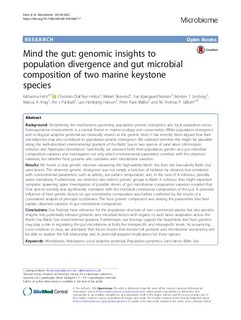| dc.contributor.author | Fietz, Katharina | |
| dc.contributor.author | Hintze, Christian O.R. | |
| dc.contributor.author | Skovrind, Mikkel | |
| dc.contributor.author | Nielsen, Tue Kjærgaard | |
| dc.contributor.author | Limborg, Morten | |
| dc.contributor.author | Krag, Marcus A. | |
| dc.contributor.author | Palsbøll, Per J. | |
| dc.contributor.author | Hansen, Lars Hestbjerg | |
| dc.contributor.author | Møller, Peter Rask | |
| dc.contributor.author | Gilbert, Marcus Thomas Pius | |
| dc.date.accessioned | 2019-09-03T05:57:20Z | |
| dc.date.available | 2019-09-03T05:57:20Z | |
| dc.date.created | 2018-11-15T16:04:35Z | |
| dc.date.issued | 2018 | |
| dc.identifier.citation | Microbiome. 2018, 6 (82), . | nb_NO |
| dc.identifier.issn | 2049-2618 | |
| dc.identifier.uri | http://hdl.handle.net/11250/2612107 | |
| dc.description.abstract | Background
Deciphering the mechanisms governing population genetic divergence and local adaptation across heterogeneous environments is a central theme in marine ecology and conservation. While population divergence and ecological adaptive potential are classically viewed at the genetic level, it has recently been argued that their microbiomes may also contribute to population genetic divergence. We explored whether this might be plausible along the well-described environmental gradient of the Baltic Sea in two species of sand lance (Ammodytes tobianus and Hyperoplus lanceolatus). Specifically, we assessed both their population genetic and gut microbial composition variation and investigated not only which environmental parameters correlate with the observed variation, but whether host genome also correlates with microbiome variation.
Results
We found a clear genetic structure separating the high-salinity North Sea from the low-salinity Baltic Sea sand lances. The observed genetic divergence was not simply a function of isolation by distance, but correlated with environmental parameters, such as salinity, sea surface temperature, and, in the case of A. tobianus, possibly water microbiota. Furthermore, we detected two distinct genetic groups in Baltic A. tobianus that might represent sympatric spawning types. Investigation of possible drivers of gut microbiome composition variation revealed that host species identity was significantly correlated with the microbial community composition of the gut. A potential influence of host genetic factors on gut microbiome composition was further confirmed by the results of a constrained analysis of principal coordinates. The host genetic component was among the parameters that best explain observed variation in gut microbiome composition.
Conclusions
Our findings have relevance for the population structure of two commercial species but also provide insights into potentially relevant genomic and microbial factors with regards to sand lance adaptation across the North Sea–Baltic Sea environmental gradient. Furthermore, our findings support the hypothesis that host genetics may play a role in regulating the gut microbiome at both the interspecific and intraspecific levels. As sequencing costs continue to drop, we anticipate that future studies that include full genome and microbiome sequencing will be able to explore the full relationship and its potential adaptive implications for these species. | nb_NO |
| dc.language.iso | eng | nb_NO |
| dc.publisher | BioMed Central | nb_NO |
| dc.rights | Navngivelse 4.0 Internasjonal | * |
| dc.rights.uri | http://creativecommons.org/licenses/by/4.0/deed.no | * |
| dc.title | Mind the gut: genomic insights to population divergence and gut microbial composition of two marine keystone species | nb_NO |
| dc.type | Journal article | nb_NO |
| dc.type | Peer reviewed | nb_NO |
| dc.description.version | publishedVersion | nb_NO |
| dc.source.pagenumber | 16 | nb_NO |
| dc.source.volume | 6 | nb_NO |
| dc.source.journal | Microbiome | nb_NO |
| dc.source.issue | 82 | nb_NO |
| dc.identifier.doi | 10.1186/s40168-018-0467-7 | |
| dc.identifier.cristin | 1631137 | |
| dc.description.localcode | Open Access This article is distributed under the terms of the Creative Commons Attribution 4.0 International License (http://creativecommons.org/licenses/by/4.0/), which permits unrestricted use, distribution, and reproduction in any medium, provided you give appropriate credit to the original author(s) and the source, provide a link to the Creative Commons license, and indicate if changes were made. | nb_NO |
| cristin.unitcode | 194,31,10,0 | |
| cristin.unitname | Institutt for naturhistorie | |
| cristin.ispublished | true | |
| cristin.fulltext | original | |
| cristin.qualitycode | 1 | |

